Coriander, or cilantro or Chinese parsley, is a common herb in many kitchens worldwide. Its use ranges from spicing Mexican and Asian cuisines to garnishing salads. The coriander seeds help make infusions, teas, aromatherapy, oils, flavoring, and more.
It is simple to sow these seeds, both outdoors and indoors. Plant coriander seeds on finely-tilled ground or planters and harvest fresh leaves or fully grown seeds for your cuisines. To expound this more and make it practical, we’ll explore the step-by-step process of growing, harvesting, and preserving coriander seeds for sale or home use. Let’s begin with the growing part of cilantro seeds.
Growing Coriander Seeds

The journey of growing coriander begins with selecting the right location and time. Also, planting viable seeds and tendering the plants from a young age to maturity will spell out your harvest. Have a look at the processes;
Selecting The Right Location
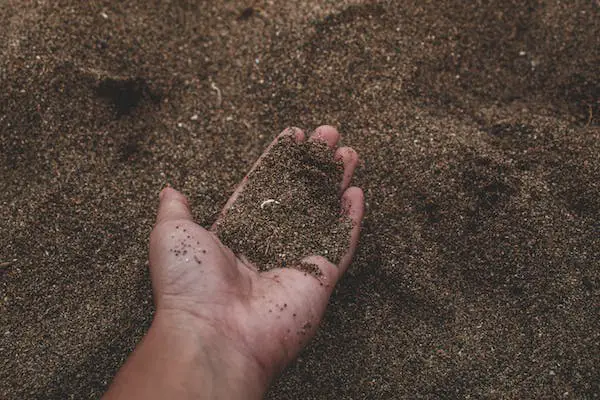
Before embarking on this journey, select the right location for your coriander crop. The plants thrive well in well-draining soil with a pH ranging from acidic to neutral.
How do you determine your soil pH? You need an expert to analyze your planting medium if you are not an agronomist. Take your soil sample to the nearest soil testing agency for analysis. Also, they will tell you if the soil drains well and how to improve it for your crop.
Still, you need a partially shady area for your coriander crop under the right location. This can be a natural shade, or you can make one. It will prevent the plants from bolting when it is hot.
Choosing The Right Time
Like the location, coriander grows best in spring and fall cooler seasons. If your region is warmer, plant coriander seeds in the fall to avoid heat stress. If you choose to plant in autumn or summer, indoor planting will suit the plants. You can use planters and position them indoors, but ensure access to sunlight. Some gardeners grow coriander in greenhouses to protect the plants from summer heat. The houses are great if you want the plants to seed too quickly.
Sowing Corriander Seeds
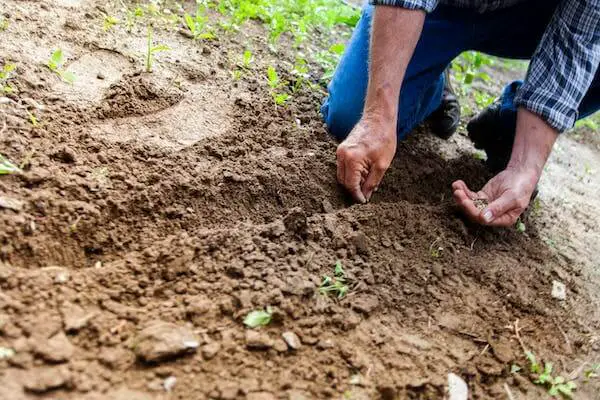
The art of sowing coriander seeds is not complex. All you need is to prepare your soil and plant the seeds. The larger the seeds, the easier it is to sow. Make shallow drills in the soil and scatter the seeds. The spacing between the drills should be about 6 inches.
Cover the seeds with compost or a little soil and water immediately. Do the same on grow bags or planters. You can also grow coriander in hydroponics. Germination takes about one to three weeks. Plant smaller batches every two or three weeks to keep a steady supply of coriander leaves in your kitchen. But if you are growing your coriander for seeds, sow them in a greenhouse or full sum during the summer or spring. This timing will ensure that your seeds mature and ripen for harvesting.
Adequate Watering

Coriander plants love moisture. To keep the seeds moist, keep watering consistently, but do not waterlog the soil. After two or three weeks, the seeds will begin sprouting. Once they fully germinate, water twice a day. Water gently to avoid breaking the stalks. Here are some guidelines to help you water your coriander plants effectively:
- Consistent moisture: Coriander prefers consistently moist but not waterlogged soil. Keep the soil consistently damp to encourage germination and steady growth.
- Water your plants frequency: Water your coriander plants regularly, especially during dry or hot weather. In warmer climates, you may need to water more frequently.
- Avoid overwatering, as coriander does not tolerate waterlogged soil well. Ensure that the soil drains perfectly to prevent root rot. Use well-draining loam soil and containers with drainage holes.
- Morning watering your coriander plants allows excess moisture to evaporate during the day. Watering in the morning helps prevent fungal diseases that can thrive in damp conditions.
- Check soil moisture regularly by inserting your finger until the first knuckle. Water if the soil feels dry at this depth.
- For container gardening, be mindful of the moisture levels. Containers may dry out more quickly than garden soil, so check them more frequently.
- Avoid wetting foliage: When watering, aim for the plant’s base to avoid wetting the foliage. Wet leaves can contribute to fungal issues.
- Adjust watering in different seasons: You may need to water more frequently in hot weather. During cooler seasons, reduce watering frequency but ensure the soil remains consistently moist.
Fertilizing Coriander
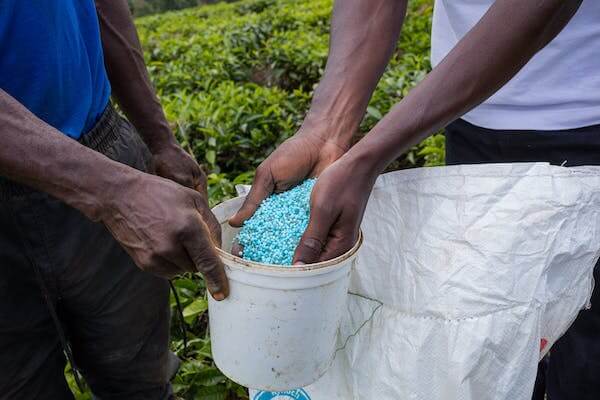
Add a balanced organic fertilizer every 4-6 weeks to enhance nutrition. With proper nutrients, your coriander plants will have healthy stalks, leaves, and flowers on time. Here are some of the recommendations for the best fertilizer for coriander:
- Use a well-balanced fertilizer: Use a general-purpose, well-balanced fertilizer with equal or near-equal proportions of nitrogen (N), phosphorus (P), and potassium (K). For example, a balanced fertilizer with an N-P-K ratio of 10-10-10 or 14-14-14 can be suitable.
- Organic fertilizer is the best option for coriander: Consider using organic fertilizers for a more sustainable and environmentally friendly option. Compost or well-rotted manure can be excellent choices for enriching the soil.
- Use slow-release granular fertilizer to provide a steady supply of nutrients over an extended period. This benefits coriander plants, ensuring they receive a consistent and balanced diet.
- Liquid fertilizer is another option, especially if you prefer a quicker response. Look for liquid fertilizers with a balanced N-P-K ratio or a formulation for herbs and vegetables.
- Use fish emulsion organic fertilizer to provide a good nitrogen source. It’s well-suited for promoting leafy growth, making it suitable for coriander leaves. Dilute according to the product instructions before application.
- Seaweed extract is another option rich in micronutrients and can enhance plant growth. It’s often used as a foliar spray or added to the soil to promote plant health.
- Add Epsom salt (magnesium sulfate) if your soil is deficient in magnesium. Dissolve the supplement in water and apply it to the soil or use it as a foliar spray.
Note that potassium-based fertilizers cause premature flowering, so use them sparingly.
Thinning Coriander Seedlings
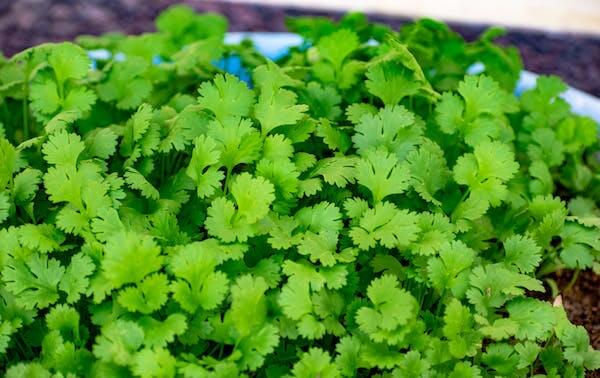
Once the seedlings are a few inches in height, thinning is essential to ensure proper air circulation. It is an easy process that involves removing the weaklings from your crop. Thin the seedlings with your hands or small scissors to ensure gentleness and avoid breaking the healthy plants with large gardening tools. It is crucial to determine a good spacing for your coriander plants.
The ideal spacing is about 6 to 8 inches apart, which allows them enough room to grow without competing for resources. Preparations before thinning include watering the soil around the coriander plants. Moist soil makes removing unwanted seedlings easier without disturbing the healthy plants’ roots. Consider using the unwanted seedlings for your culinary arts, including salads or other dishes. Remember to water your plants after thinning.
Harvesting Coriander Leaves
When growing coriander, you can harvest and use the leaves in your cooking. You can also dry some with a dehydrator and store them for future use. Harvest the leaves when the plant reaches about 6 inches in height. The right procedure is to snip the outer leaves to allow the inner ones to continue growing.
Bolting and flowering

The cilantro/coriander has a growth pattern that includes the vegetative phase, bolting, flowering, and seed formation. The coriander produces leaves during vegetative growth and establishes a strong root system. This phase can last several weeks, primarily the leaf development phase.
Next is the bolting phase, which forms the central stalk and small flower heads. The bolting phase is a preparation for seed formation. After this process, the flowers fully bloom and produce seeds. In coriander, flowering signals that the environmental condition is conducive to reproduction. The temperatures are higher, and it is late spring or early summer.
Harvesting coriander Seeds
When the seeds are fully formed, they will start turning brown. Make sure that they are dry before harvesting. You can pick the seeds and peel them to see if they are dry inside. That should be before they start falling off a few weeks after blooming.
Gently cut the head with pruning shears or shake the seeds into a container. Allow them to air dry for a few weeks in a well-aerated area. Once the seeds are thoroughly dry, thresh them to separate them from the seed heads. You can rub the seed heads between your hands or gently crush them in a bag. Clean the seeds by winnowing or using a fine-mesh sieve to remove debris or trash. Air dry the clean seeds in a single layer on a tray for an additional week. To facilitate complete drying, stir them occasionally.
Storage
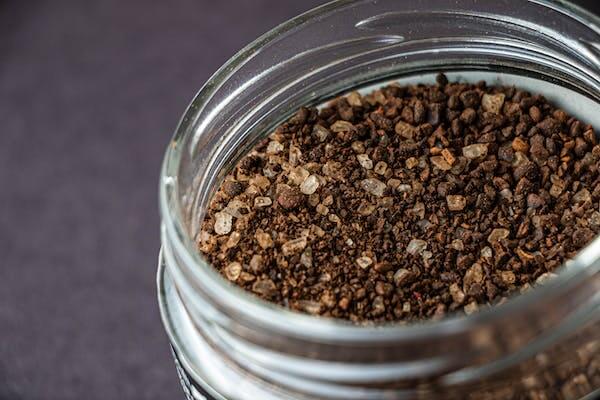
Store the dried coriander seeds in a cool, dry place. Airtight containers are perfect for labeling the storage container with the harvest date and the coriander variety (if applicable). This information can be helpful for future planting or culinary use.
Uses And Benefits Of Coriander Seeds
The coriander seeds are a versatile spice with a distinctive flavor profile that adds depth and complexity to various dishes. Here is a list of common uses for coriander seeds:
- Cooking Spice: Coriander seeds are a key ingredient in many spices and blends, such as curry powder, garam masala, and berbere.
- Flavoring Curries and Stews: Use ground or whole coriander seeds to flavor Indian, Middle Eastern, and Southeast Asian curries, stews, and sauces.
- Pickling Spices: Coriander seeds are ingredients in pickling brines, providing a warm and citrusy flavor to pickled vegetables.
- Baking: Ground coriander is a great addition to baking recipes, particularly gingerbread, spice cookies, and certain cakes.
- Homemade Sauces and Marinades: Incorporate crushed coriander seeds into homemade sauces, marinades, and rubs for meat and vegetables.
- Sausage Making: Coriander seeds are a popular spice in sausage making, adding a unique flavor to various types of sausages.
- Curing Meats: Ground coriander is sometimes used in the curing process for meats, contributing to the overall flavor profile.
- Flavoring Rice and Grains: Add whole coriander seeds to rice, couscous, and other grains during cooking to infuse them with a subtle citrusy flavor.
- Tea and Infusions: Coriander seeds can make a soothing tea or infusion. Herbalists believe that the seeds have digestive and anti-inflammatory properties.
- Homemade Spice Oils: Infuse oil with coriander seeds to create a flavorful base for dressings, marinades, or drizzling over dishes.
- Digestive Aid: Coriander seeds have digestive properties. You can chew or use them in herbal remedies to alleviate digestive issues.
- Coriander Water: Soak coriander seeds overnight and then strain the water to detoxify your body. The water also acts as a diuretic.
- Mouth Freshener: Many cultures commonly use Roasted coriander seeds as a natural mouth freshener.
- Homemade Liqueurs: Coriander seeds can make great air fresheners for home use.
- Medicinal Uses: Coriander seeds have various health benefits in traditional medicine, including anti-inflammatory and anti-microbial properties.
- Aromatherapy: The coriander essential oils have calming and uplifting properties, thus great for aromatherapy.
Conclusion
Undoubtedly, you have a complete guide on growing, harvesting, and preserving coriander seeds. In the growing process, you can always enjoy organic green leafy cilantro from your kitchen garden. And with this article, the journey will be easy. Bookmark this guide so you can consult if you get stuck. Also, share your coriander growing journey with us.
Best wishes!

